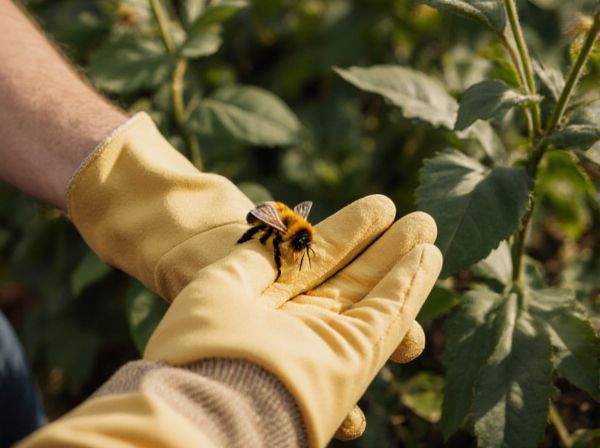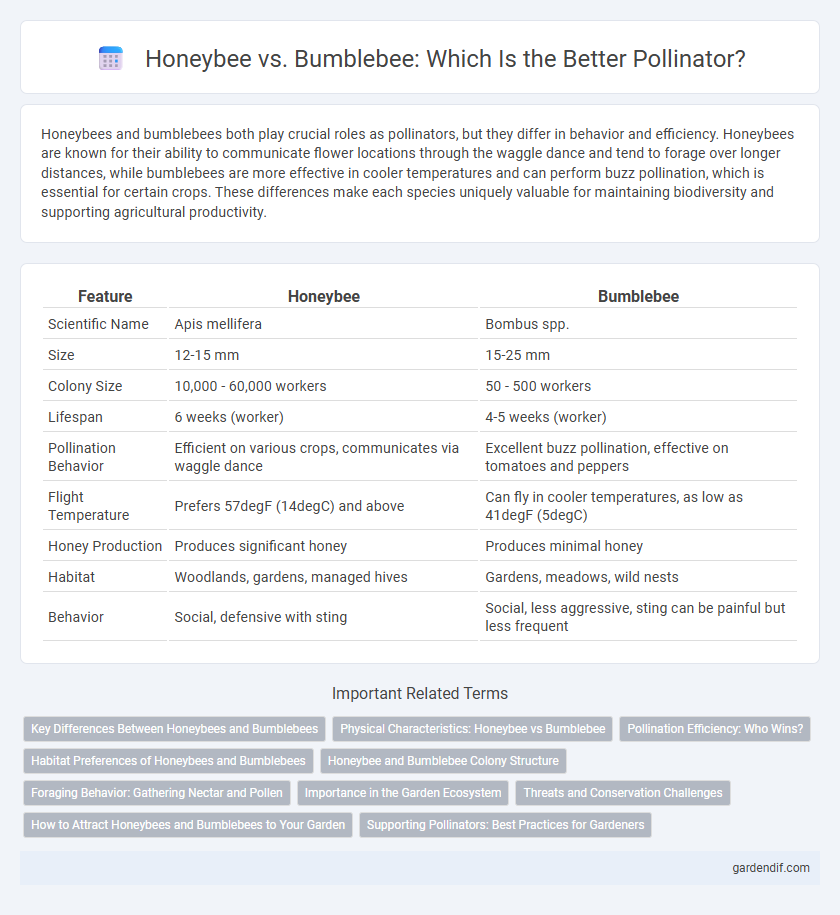
Honeybee vs Bumblebee Illustration
Honeybees and bumblebees both play crucial roles as pollinators, but they differ in behavior and efficiency. Honeybees are known for their ability to communicate flower locations through the waggle dance and tend to forage over longer distances, while bumblebees are more effective in cooler temperatures and can perform buzz pollination, which is essential for certain crops. These differences make each species uniquely valuable for maintaining biodiversity and supporting agricultural productivity.
Table of Comparison
| Feature | Honeybee | Bumblebee |
|---|---|---|
| Scientific Name | Apis mellifera | Bombus spp. |
| Size | 12-15 mm | 15-25 mm |
| Colony Size | 10,000 - 60,000 workers | 50 - 500 workers |
| Lifespan | 6 weeks (worker) | 4-5 weeks (worker) |
| Pollination Behavior | Efficient on various crops, communicates via waggle dance | Excellent buzz pollination, effective on tomatoes and peppers |
| Flight Temperature | Prefers 57degF (14degC) and above | Can fly in cooler temperatures, as low as 41degF (5degC) |
| Honey Production | Produces significant honey | Produces minimal honey |
| Habitat | Woodlands, gardens, managed hives | Gardens, meadows, wild nests |
| Behavior | Social, defensive with sting | Social, less aggressive, sting can be painful but less frequent |
Key Differences Between Honeybees and Bumblebees
Honeybees are smaller, with a slender, more streamlined body covered in fine hairs, whereas bumblebees are larger and robust, featuring a fuzzier appearance with dense hair aiding in pollen collection. Honeybees live in highly structured colonies with a single queen and thousands of workers, while bumblebees form smaller, less organized nests typically consisting of a few hundred individuals. Foraging behavior also differs: honeybees can travel longer distances and communicate precisely through the "waggle dance," whereas bumblebees forage closer to nests and rely more on individual memory for flower locations.
Physical Characteristics: Honeybee vs Bumblebee
Honeybees possess a slender, golden-brown body with fine hair and transparent wings, measuring about 12-15mm, which aids in efficient nectar foraging. Bumblebees are larger, ranging from 20-23mm, characterized by their robust, fuzzy black and yellow bodies that provide insulation for low-temperature activity. The distinct body shapes and hair density directly influence their pollination techniques and flower preferences.
Pollination Efficiency: Who Wins?
Honeybees exhibit high pollination efficiency due to their ability to visit numerous flowers rapidly and their specialized pollen-carrying structures called corbiculae. Bumblebees excel in pollinating plants with deep or complex flowers by performing buzz pollination, which releases more pollen per visit and enhances fertilization. While honeybees dominate in large-scale agricultural pollination, bumblebees often achieve superior pollination quality in diverse ecosystems and greenhouse crops.
Habitat Preferences of Honeybees and Bumblebees
Honeybees prefer habitats with abundant flowering plants in open fields, orchards, and gardens, often nesting in hollow trees or man-made hives. Bumblebees thrive in cooler climates and are commonly found in meadows, grasslands, and forest edges, nesting underground or in dense vegetation. Both species contribute significantly to pollination but select distinct environments that support their colony development and resource needs.
Honeybee and Bumblebee Colony Structure
Honeybee colonies consist of a single reproductive queen, thousands of sterile female worker bees, and a few male drones, forming a highly organized structure with distinct roles such as foraging, nursing, and hive maintenance. Bumblebee colonies are smaller, with a queen and a few hundred workers, often lacking the rigid caste differentiation seen in honeybees, and their colonies are annual rather than perennial. The social organization of honeybees supports efficient pollination through coordinated foraging, while bumblebees demonstrate flexibility in colony roles that adapt to varying environmental conditions.
Foraging Behavior: Gathering Nectar and Pollen
Honeybees exhibit a highly organized foraging behavior, efficiently collecting nectar and pollen by visiting multiple flowers in a single trip and communicating locations through the waggle dance. Bumblebees gather nectar and pollen with a more flexible approach, often foraging in cooler temperatures and lower light conditions, allowing them to exploit different floral resources. Their ability to buzz pollinate enhances pollen collection from flowers with poricidal anthers, giving them an advantage in certain ecosystems.
Importance in the Garden Ecosystem
Honeybees and bumblebees are vital pollinators that enhance garden biodiversity and crop yield by facilitating the reproduction of flowering plants through efficient pollen transfer. Honeybees, with their structured hive systems and ability to cover large foraging ranges, contribute significantly to large-scale pollination, while bumblebees excel in cooler temperatures and shaded environments, making them indispensable for early spring and high-altitude garden ecosystems. Their complementary pollination behaviors support a resilient and productive garden ecosystem, ensuring healthy plant growth and promoting ecological balance.
Threats and Conservation Challenges
Honeybees and bumblebees face threats from habitat loss, pesticide exposure, and climate change, which contribute to declining populations worldwide. Honeybees are particularly vulnerable to Colony Collapse Disorder and Varroa mite infestations, while bumblebees struggle with limited nesting sites and floral resource depletion. Conservation efforts focus on habitat restoration, reducing pesticide use, and promoting diverse forage to support both pollinator species' survival and ecosystem health.
How to Attract Honeybees and Bumblebees to Your Garden
Honeybees and bumblebees can be attracted to your garden by planting a diverse range of native flowering plants that bloom at different times, providing a continuous source of nectar and pollen. Incorporate herbs like lavender, thyme, and mint alongside wildflowers such as coneflowers and black-eyed Susans to create an inviting habitat. Avoid pesticides and provide shallow water sources to support their foraging and nesting activities effectively.
Supporting Pollinators: Best Practices for Gardeners
Honeybees and bumblebees both play crucial roles in pollination, but supporting their populations requires different garden practices. Planting a diverse range of native flowering plants that bloom throughout the season provides continuous nectar sources for these pollinators. Avoiding pesticides, creating habitats with nesting materials, and ensuring access to water enhances the survival and efficiency of honeybees and bumblebees in garden ecosystems.
Honeybee vs Bumblebee Infographic

 gardendif.com
gardendif.com